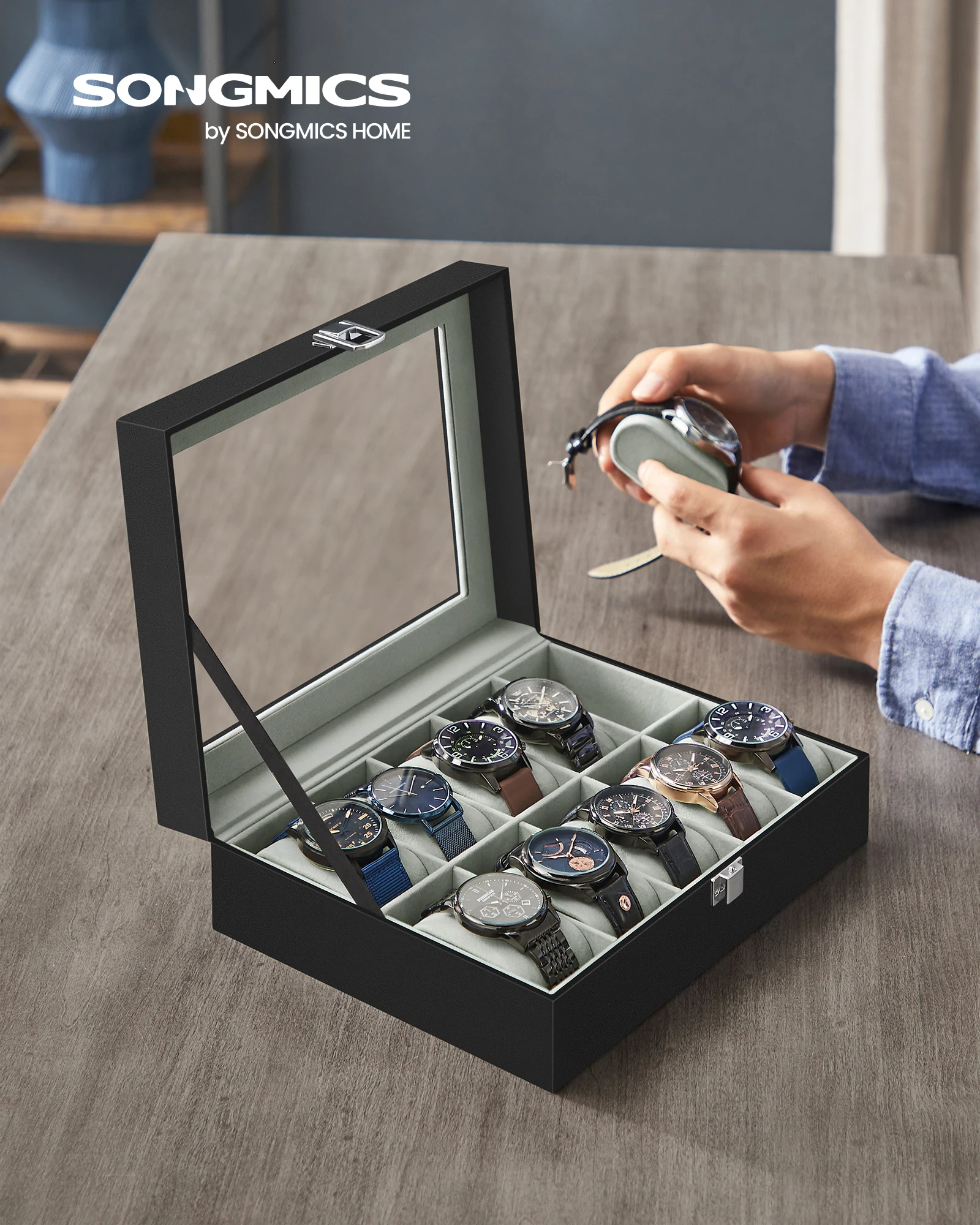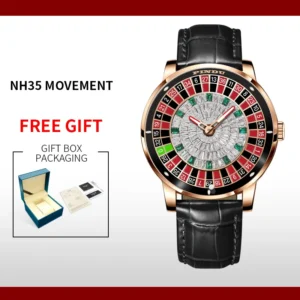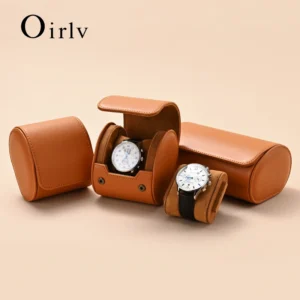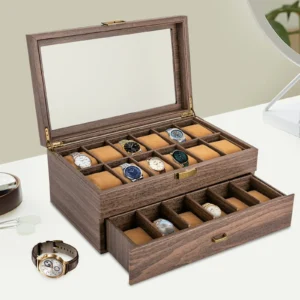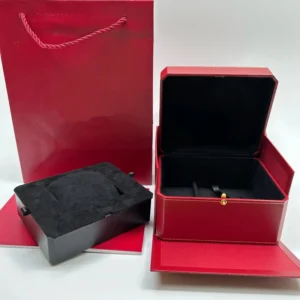Introduction: The Art and Science of Watch Storage
Proper watch storage is essential for protecting your valuable timepieces and ensuring they maintain their beauty, functionality, and value over time. More than just a place to keep watches when they’re not on your wrist, quality storage solutions shield these precision instruments from dust, moisture, and physical damage that can affect performance and appearance.
Studies suggest that watches stored properly can maintain their accuracy up to 70% longer between service intervals, potentially saving hundreds in maintenance costs over the life of the timepiece. Meanwhile, collectors who invest in proper storage report fewer incidents of cosmetic damage and mechanical issues.
The watch storage market offers diverse solutions to meet different needs:
– Protection-focused cases that minimize environmental exposure
– Specialized winders that keep automatic watches running
– Display options that balance visibility with security
– Travel solutions that provide protection on the move
Choosing the right storage depends heavily on your collection’s specific needs. Whether you have one special timepiece or dozens of watches, understanding watch collection storage planning principles helps you make better decisions about protection and presentation.
Today’s watch boxes come in various configurations, materials, and designs to accommodate everything from casual everyday watches to high-end luxury timepieces.
Understanding Your Watch Collection Needs
Before selecting a storage solution, take time to assess what your collection actually requires. Different watch types have distinct storage needs—a crucial consideration often overlooked by collectors.
Automatic watches benefit from movement, either through regular wear or with specialized winders that keep them running. Without this motion, they’ll eventually stop and require resetting. Quartz watches, on the other hand, simply need protection from physical damage and battery leakage. Manual wind watches fall somewhere in between, requiring occasional winding but no continuous motion.
Consider these factors when evaluating your storage needs:
- Current collection size and anticipated growth
- Watch types (automatic, quartz, manual)
- Frequency of wear for each piece
- Value of your timepieces and security requirements
- Display preferences (hidden storage vs. visible display)
- Budget allocation for storage solutions
- Space available for your storage system
Expert collectors recommend planning for at least 25% more capacity than your current collection size, accounting for future acquisitions. For valuable collections, security features become increasingly important, with some high-end storage options offering fingerprint access, fireproof construction, and even remote monitoring.
Effective organizing watch collection strategies help maximize both protection and accessibility, ensuring your timepieces remain in optimal condition whether worn daily or stored for special occasions.
Traditional Watch Boxes: Classic Protection and Organization
Traditional watch boxes remain the most popular and versatile storage solution for most collectors. These enclosed cases with individual cushions offer excellent organization while protecting timepieces from dust, light exposure, and minor physical impacts.
Watch boxes typically come in several capacity options:
– Single watch boxes for special timepieces
– 2-3 slot boxes for small collections
– 6-12 slot boxes for moderate collections
– 12+ slot options for extensive collections
The design of traditional watch boxes generally includes:
– A hinged or removable lid for easy access
– Individual compartments with cushions or pillows
– Interior lining that prevents scratches
– Additional storage for accessories in some models
Pros:
- Excellent organization with dedicated slots for each piece
- Good protection from dust and environmental factors
- Visually appealing designs that complement home décor
- Generally more affordable than specialized storage
- Available in numerous sizes and configurations
Cons:
- No winding function for automatic watches
- Limited portability for larger boxes
- Can be bulky in smaller living spaces
- Basic models offer limited security features
Traditional watch boxes work particularly well for mixed collections containing both automatic and quartz watches, or for collectors who wear their automatic pieces regularly enough to keep them running. For larger collections, 12 watch box options provide efficient organization while maintaining a reasonable footprint.
Material Variations in Traditional Watch Boxes
The materials used in watch boxes significantly impact both their protective qualities and aesthetic appeal. Each material offers distinct benefits worth considering:
Wood options provide natural beauty and stability:
– Oak: Durable with distinctive grain patterns
– Walnut: Rich, dark appearance with excellent durability
– Cedar: Natural resistance to moisture and insects
– Mahogany: Premium look with warm reddish tones
Wooden watch boxes generally maintain more stable interior humidity levels than synthetic alternatives, an important factor for mechanical watch preservation. They also tend to age gracefully, developing character over time.
Leather exteriors offer sophisticated aesthetics:
– Genuine leather: Natural material with unique grain patterns
– PU leather: More consistent appearance, lower cost
– Full-grain leather: Maximum durability with natural markings
– Vegetable-tanned leather: Environmentally friendly processing
Leather watch boxes often feature a softer, more luxurious feel and pair especially well with leather-strapped watches. They typically include reinforced internal structures for durability.
Interior lining materials also matter significantly:
– Velvet: Soft texture that prevents scratches
– Suede: Natural material with excellent cushioning
– Microfiber: Synthetic option that resists dust
– Silk: Premium feel with natural properties
The best box materials absorb minor shocks, maintain stable interior conditions, and prevent watch bracelet scratches—all while complementing your home décor and reflecting the quality of the timepieces themselves.
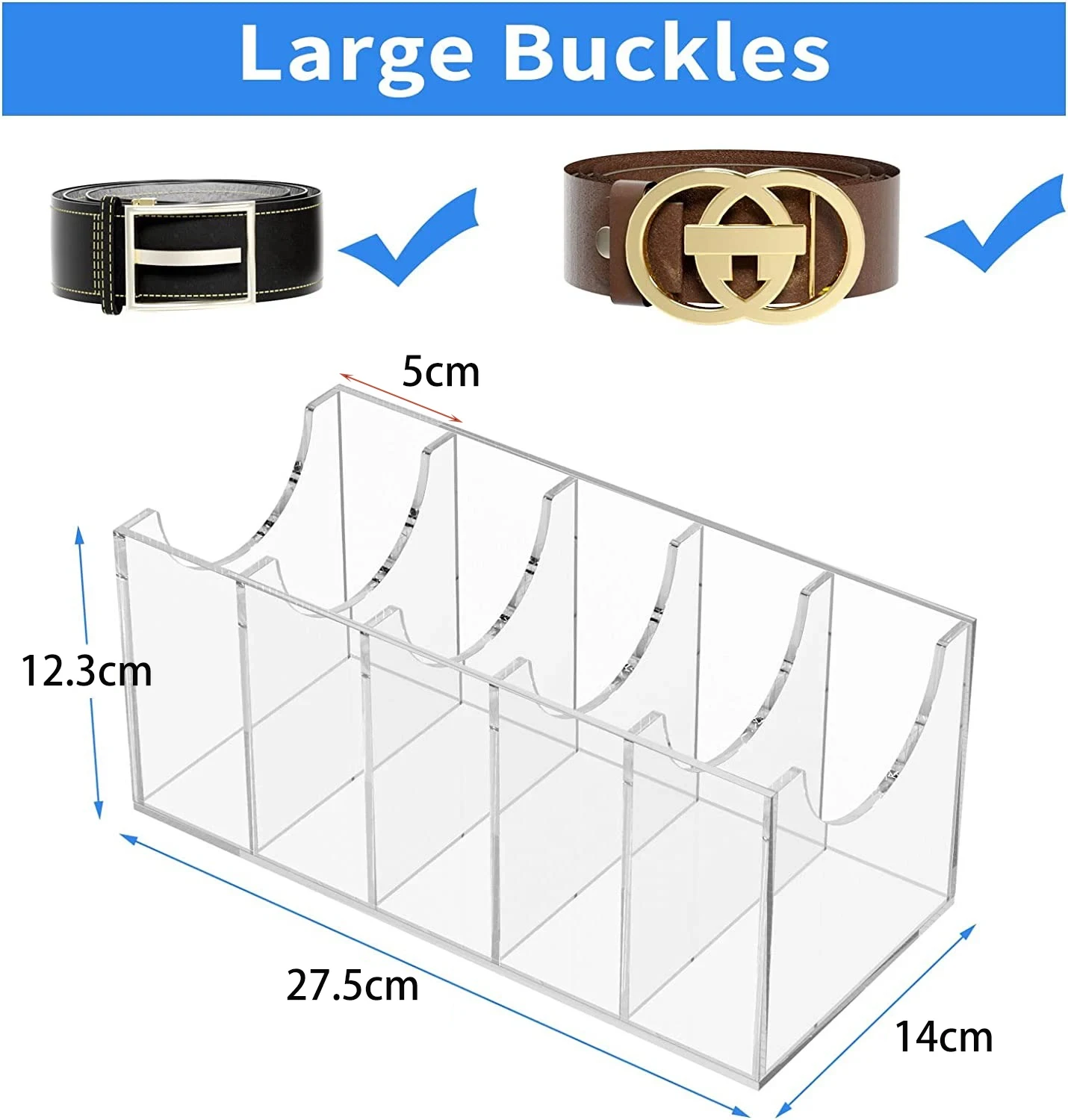
Watch Winders: Keeping Your Automatics Running
Watch winders serve a specific purpose in the collector’s arsenal—they keep automatic (self-winding) watches running when not worn. These specialized devices mimic the natural motion of your wrist, rotating watches at programmed intervals to maintain power reserve and keep the internal mechanisms functioning properly.
Understanding the mechanics helps appreciate their value: automatic watches contain weighted rotors that wind the mainspring when in motion. Without this movement, the watch eventually stops, requiring manual resetting of the time and any complications (date, day, moon phase, etc.). For watches with complex features, this reset process can be time-consuming.
Watch winders come in various configurations:
– Single winders for one special timepiece
– Double winders for primary rotation pieces
– Multi-watch winders for larger automatic collections (4-24+ slots)
Key technical features to evaluate include:
– Turns Per Day (TPD) settings: Typically ranging from 650-1,950 TPD
– Rotation direction options: Clockwise, counterclockwise, or bidirectional
– Motor types: AC-powered or battery operation
– Programming flexibility: Fixed vs. customizable rotation patterns
Advanced winders may include:
– Individual motors for each watch position
– LCD displays showing current settings
– Sleep mode functionality to extend motor life
– Quiet operation technology for bedroom placement
Watch winders excel at maintaining complicated timepieces in ready-to-wear condition. However, they represent a more significant investment than basic storage, with quality units typically starting at $100 for single winders and reaching thousands for premium multi-watch systems.
The difference between economy and premium winders often comes down to motor quality, with higher-end models offering quieter operation, more precise rotation control, and better long-term reliability. Understanding the specific watch winder rotation modes comparison can help you select the appropriate model for your collection.
Selecting the Right Watch Winder Settings
Proper winder settings are crucial for maintaining automatic watches without causing undue wear. The two most important parameters are Turns Per Day (TPD) and rotation direction.
TPD refers to how many complete rotations the watch makes in a 24-hour period. Setting this incorrectly can either fail to maintain power reserve (if too low) or potentially create excessive wear on components (if too high). Most automatic watches fall within these ranges:
| Watch Brand | Recommended TPD | Direction |
|---|---|---|
| Rolex | 650-750 | Bidirectional |
| Omega | 650-800 | Bidirectional |
| Seiko | 500-800 | Bidirectional |
| TAG Heuer | 800-1,000 | Either direction |
| Patek Philippe | 800-1,000 | Either direction |
| Most other brands | 650-850 | Check manual |
Rotation direction also matters for some watches:
– Clockwise only: Some older watches with unidirectional winding systems
– Counterclockwise only: Rare specialty movements
– Bidirectional: Most modern automatic watches
Common setting mistakes include:
– Using excessive TPD “just to be sure” (risks overwinding)
– Ignoring manufacturer specifications for direction
– Running winders continuously without rest periods
For collectors with multiple automatic watches, rotating them through winder positions can extend the life of both the watches and the winding mechanism. This practice helps prevent lubricant stagnation without requiring continuous winding for every piece.
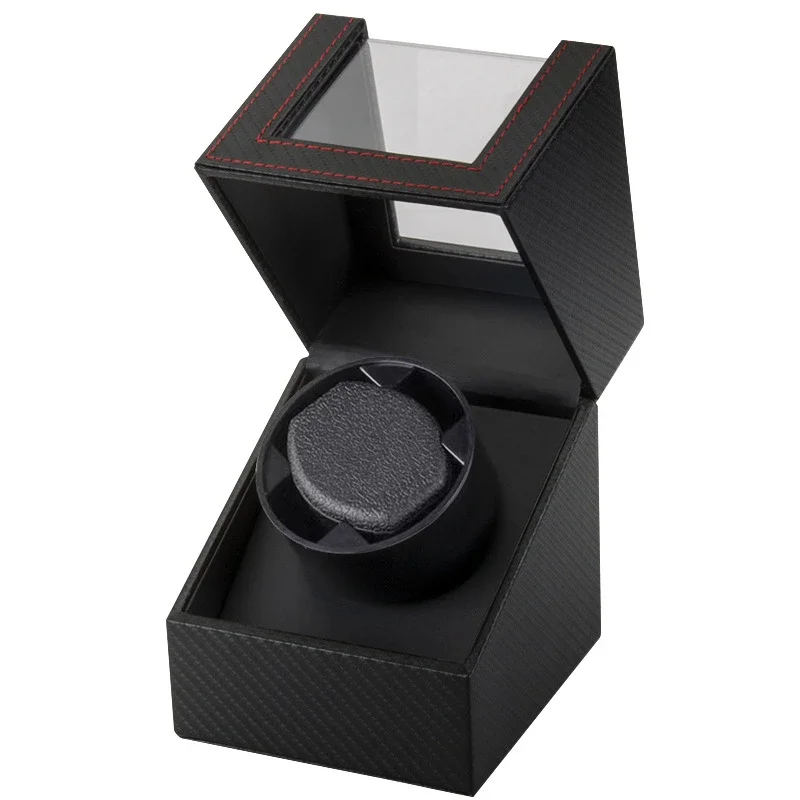
Travel Watch Cases: Protection on the Move
For watch enthusiasts who travel regularly, specialized portable storage solutions provide essential protection from the unique risks of transportation. Unlike stationary storage, travel cases must guard against more severe physical impacts while maintaining a compact profile.
Watch rolls represent one of the most popular travel options. These cylindrical cases typically hold 2-4 watches in individual compartments, with cushioned dividers preventing contact between pieces. Made from leather, canvas, or synthetic materials, they combine protection with elegant design and roll up for compact storage.
Single and multi-watch pouches offer even more compact solutions for limited space. These soft, padded envelopes provide basic protection for individual watches, ideal for overnight trips or when carrying a single backup timepiece. Some feature microfiber interiors that clean the watch face while stored.
Hard-shell travel cases provide maximum protection for valuable watches during travel:
– Crush-resistant exteriors prevent physical damage
– Custom-fit foam interiors immobilize watches completely
– Waterproof seals protect against moisture and dust
– Security features deter theft and unauthorized access
The best watch travel cases balance protection with practicality. Premium models often feature water resistance ratings of IPX7 or higher (submersible to 1 meter) and impact resistance certifications.
Closure mechanisms vary widely in security and convenience:
– Zippers offer quick access but variable security
– Snap closures provide moderate security with one-handed operation
– Buckle systems offer traditional security with aesthetic appeal
– Combination locks provide significant security for valuable collections
Travel cases excel during business trips, vacations, or when transporting watches to service appointments. Their specialized design addresses the risks of motion, pressure changes, and varied environmental conditions encountered during travel.
Display Cases and Cabinets: Showcasing Your Collection
For many collectors, watches represent not only functional timepieces but also objects of beauty deserving display. Display-focused storage solutions address this desire, balancing visibility with protection.
Tabletop display boxes feature transparent lids made from glass or acrylic, allowing visual enjoyment of the collection even when watches aren’t being worn. Wall-mounted cabinets expand this concept, turning watch collections into room focal points similar to fine art displays.
Key features to evaluate in display-oriented storage include:
– Glass quality (standard, tempered, or sapphire crystal)
– Acrylic clarity and scratch resistance
– Viewing angle optimization
– UV protection to prevent dial fading
– Interior lighting placement and quality
Advanced watch display holders often incorporate LED lighting with adjustable brightness and color temperature. This illumination enhances appreciation of dial details, case finishing, and movement intricacies through exhibition casebacks.
Security remains a critical consideration for displayed collections. Quality watch display case options balance visibility with protection through:
– Impact-resistant viewing panels
– Locking mechanisms for unauthorized access prevention
– Hidden hinges that resist tampering
– Interior anchoring systems for valuable pieces
The primary advantage of display-focused storage is the ability to appreciate your collection even when pieces aren’t being worn. Studies suggest collectors with visible storage tend to rotate through their collections more frequently, increasing enjoyment and ensuring mechanical watches receive movement.
The primary disadvantages include light exposure (potentially fading dials over time) and increased security risks compared to fully enclosed storage. For this reason, many collectors reserve display storage for daily wear pieces while keeping their most valuable watches in more secure, enclosed environments.
Watch Accessories, Watch Holder
$94.51 Select options This product has multiple variants. The options may be chosen on the product pageLuxury Watch Boxes, Men's Watch Boxes, Single Watch Box
Price range: $903.35 through $980.97 Select options This product has multiple variants. The options may be chosen on the product pageSingle Watch Travel Case, Watch and Jewelry Box, Watch Roll Travel Case
Price range: $93.44 through $140.65 Select options This product has multiple variants. The options may be chosen on the product pageMen's Watch Organizer, Watch Display Case, Watch Organizer
Price range: $112.68 through $169.45 Select options This product has multiple variants. The options may be chosen on the product pageAutomatic Watch Winder, Luxury Watch Winder, Single Watch Box
$307.39 Select options This product has multiple variants. The options may be chosen on the product pageLuxury Watch Boxes, Luxury Watch Travel Case
Price range: $200.33 through $224.57 Select options This product has multiple variants. The options may be chosen on the product page
Material Considerations Across Storage Types
Material selection significantly impacts both protection quality and aesthetic appeal across all storage solutions. Each material offers distinct advantages and limitations worth evaluating against your specific needs.
Wood remains the most popular traditional choice for quality watch storage:
– Oak provides excellent durability with a classic grain pattern
– Walnut offers rich, dark tones that complement most watch designs
– Cedar naturally repels insects and helps control humidity
– Mahogany provides premium appearance with structural stability
Wood storage typically requires minimal maintenance—occasional dusting and avoiding direct sunlight prevents most issues. Quality wooden cases typically last decades with proper care.
Leather (both genuine and synthetic) offers sophisticated aesthetics:
– Full-grain leather develops a desirable patina over time
– Top-grain leather balances durability with consistent appearance
– Synthetic options provide similar appearance at lower cost points
– Vegetable-tanned leather avoids harsh chemicals for environmentally conscious collectors
Leather cases typically require conditioning 1-2 times yearly to prevent drying and cracking, particularly in low-humidity environments.
Modern materials provide specialized benefits:
– Carbon fiber offers exceptional strength-to-weight ratio
– Aluminum provides lightweight durability with modern aesthetics
– Steel construction offers maximum security for valuable collections
– Specialized alloys combine corrosion resistance with premium appearance
Glass and acrylic components are crucial for display-oriented storage:
– Standard glass provides good clarity at lower cost points
– Tempered glass offers superior impact resistance
– Sapphire crystal provides maximum scratch resistance (but at premium prices)
– High-quality acrylic balances weight, clarity, and impact resistance
Interior materials directly contact your watches and deserve careful consideration:
– Velvet provides traditional cushioning with excellent scratch prevention
– Suede offers natural texture with good protection
– Microfiber combines dust resistance with gentle surface contact
– Silk provides premium feel but may require more maintenance
Understanding the specific benefits and limitations of various materials helps make informed decisions when comparing different watch storage options. Many collectors find the wood vs. leather watch storage decision particularly important for balancing aesthetics with protection.
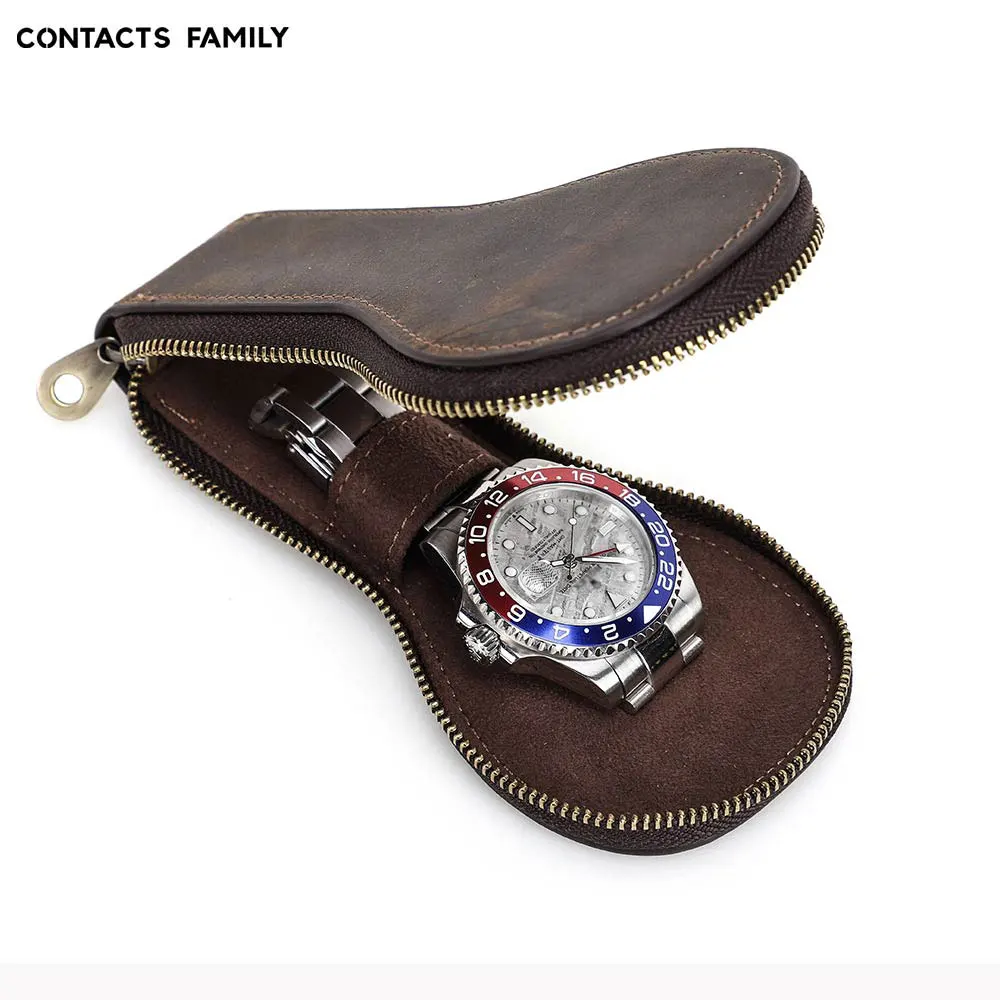
Advanced Features and Innovations in Watch Storage
Modern watch storage solutions increasingly incorporate technology to address collector concerns beyond basic protection. These innovations enhance both security and convenience while extending the lifespan of valuable timepieces.
Smart features have transformed premium watch storage:
– Bluetooth connectivity allows remote monitoring of winder function
– App control enables custom winding programs for specific watch models
– Fingerprint sensors provide secure access without keys or combinations
– Climate monitoring alerts owners to potentially harmful conditions
Humidity control represents one of the most valuable advancements in watch preservation:
– Cedar wood naturally regulates humidity levels
– Silica gel packets provide basic moisture absorption
– Electronic systems maintain precise humidity between 45-60% (ideal for watches)
– Two-way humidity control both adds and removes moisture as needed
Anti-magnetic shielding addresses the growing problem of magnetism affecting mechanical watch accuracy. Quality storage now often includes mu-metal linings that prevent magnetic fields from reaching sensitive watch components.
Organizational innovations improve the collector experience:
– Specialized compartments for straps, tools, and documentation
– Modular designs that expand with growing collections
– Integrated watch testing equipment (timing, water resistance)
– Custom foam inserts for unusual case shapes and sizes
For serious collectors, luxury watch storage setup often combines multiple solution types into comprehensive systems. These might include secure cabinets with integrated winders, display sections for regular wear pieces, and travel cases that maintain consistent storage conditions on the move.
How to Choose: Decision Guide Based on Collection Type
Selecting the ideal storage solution depends largely on your specific collection profile and usage patterns. Consider these recommendations based on common collector scenarios:
New collector with 1-3 watches:
– A quality 3-5 position traditional box offers room to grow
– Consider a single winder if one piece is automatic
– Focus on protection rather than display features
– Budget range: $50-150 for balanced quality and features
Automatic watch enthusiast with 5+ timepieces:
– Multi-position winder for frequently worn pieces
– Traditional box for less frequently worn watches
– Consider security features if collection value exceeds $5,000
– Budget range: $200-500 for core storage solutions
Frequent traveler with valuable pieces:
– Invest in a quality travel case with impact protection
– Consider watch rolls for business trips (2-3 watches)
– Maintain home storage for collection remainder
– Budget range: $100-300 for quality travel solutions
Display-focused collector:
– Glass-top cases or wall-mounted cabinets
– Ensure UV protection to prevent dial fading
– Consider location carefully (avoid direct sunlight)
– Budget range: $150-500 depending on capacity and features
Large collection requiring organization:
– Multiple specialized storage solutions by watch type
– Inventory system to track locations and service history
– Security considerations for valuable pieces
– Budget range: $500+ for comprehensive systems
When evaluating options, prioritize protection for your most valuable or sentimental pieces first. Many collectors develop watch storage ideas collectors appreciate by combining different solution types rather than seeking a single perfect option.
Future-proofing your storage requires anticipating collection growth. Most collectors find their collections expand more rapidly than initially expected, making modular or expandable systems particularly valuable.
Care and Maintenance of Watch Storage Solutions
Proper maintenance of watch storage ensures both the longevity of the storage itself and continued protection for your timepieces. Establishing a regular maintenance routine prevents common problems.
For wooden storage components:
– Dust weekly with a soft microfiber cloth
– Apply quality furniture polish quarterly (avoid silicon-based products)
– Keep away from direct sunlight to prevent fading
– Maintain consistent room humidity (40-60%) to prevent warping
For leather elements:
– Clean with a slightly damp cloth monthly
– Apply leather conditioner twice yearly
– Avoid direct sunlight which causes drying and cracking
– Address spills immediately to prevent staining
For mechanical components in winders:
– Follow manufacturer guidelines for maintenance intervals
– Listen for unusual sounds indicating motor wear
– Replace batteries in battery-operated models annually
– Consider professional service every 3-5 years for premium units
Interior components require periodic attention:
– Replace cushions showing compression or damage
– Clean pillows and lining according to material guidelines
– Inspect for signs of wear that could transfer to watches
– Consider replacement if interior materials show deterioration
Environmental factors significantly impact storage longevity:
– Maintain room temperature between 65-75°F (18-24°C)
– Avoid locations with temperature fluctuations (near windows, HVAC vents)
– Control humidity to prevent mold, corrosion, and material damage
– Limit direct sunlight exposure to all storage components
Proper long-term watch storage protection practices ensure both your timepieces and their storage solutions remain in excellent condition for decades.
Is a Watch Winder Necessary? Evaluating Real Needs
Whether a watch winder represents a necessary investment or an optional luxury depends entirely on your specific collection and wearing habits.
When winders provide genuine benefits:
– For collections with complicated automatic watches (annual calendars, perpetual calendars, moon phases)
– When you rotate between multiple automatic watches throughout the week
– For watches with accuracy specifications that benefit from constant running
– When convenience of having watches ready-to-wear outweighs cost considerations
When winders may be unnecessary:
– For primarily quartz-based collections
– For automatic watches worn daily (natural wrist movement is sufficient)
– When budget constraints make quality winders prohibitive
– For watches only worn occasionally (manual resetting may be more economical)
The cost-benefit analysis varies by collection value. For watches valued over $5,000, quality winders typically represent less than 5% of the timepiece value while potentially reducing service costs and increasing convenience.
Watchmakers generally agree that quality winders neither harm nor significantly benefit most modern automatic movements when properly set. However, for vintage watches or pieces with complex complications, professional opinion often favors either regular wearing or proper winding.
For those deciding between different storage approaches, understanding the specific advantages of watch box vs. watch roll options helps determine the best combination for your needs.
Best Storage Practices for Long-Term Watch Preservation
For watches stored for extended periods, specialized practices maximize preservation and minimize potential issues when returning pieces to regular use.
Clean thoroughly before storage: Remove all dirt, oils, and moisture that could damage surfaces or movements during extended storage.
Wind mechanical watches fully: Ensure mainsprings aren’t stored in fully unwound positions, which can affect lubricant distribution.
Set complications to safe positions: For watches with calendar functions, avoid periods when date change mechanisms are engaged (typically 9PM-3AM).
Control environmental conditions: Maintain consistent temperature (65-75°F/18-24°C) and humidity (40-60%) to prevent corrosion and material degradation.
Provide air circulation: Avoid completely airtight containers which can trap moisture and accelerate corrosion in some conditions.
Position watches properly: Store with crystals facing up to minimize pressure on crowns and pushers.
Document collection details: Maintain records of purchase information, service history, and serial numbers for insurance and authentication purposes.
Vintage timepieces require special consideration, including more frequent rotation to redistribute lubricants and specialized humidity control to preserve fragile dial finishes and paper components.
Insurance implications of storage choices deserve attention. Many policies limit coverage for watches not stored in safes or secure containers, potentially affecting reimbursement for theft or damage. Check your specific policy requirements and consider riders for valuable pieces.
Frequently Asked Questions About Watch Storage
How many watches should ideally be stored in one box?
While boxes are rated by capacity, optimal storage typically means using 70-80% of available slots to prevent crowding and potential contact between pieces. For instance, a 12-slot box works best with 8-10 watches, allowing easier access and better air circulation.
Can quartz watches be stored in winders?
Yes, but it’s unnecessary and potentially wasteful. Winders provide no benefit to quartz movements and may reduce battery life if the watch has power-saving features that activate when stationary.
How often should watch winders be serviced?
Quality winders typically require professional service every 3-5 years, similar to the watches themselves. Signs that service is needed include unusual noises, inconsistent rotation, or failure to maintain proper watch power reserve.
What’s the best way to store watches during travel?
For short trips, dedicated watch rolls or travel cases provide balanced protection and convenience. For longer journeys, consider travel cases with impact protection and water resistance. Always carry valuable timepieces in carry-on luggage rather than checked baggage.
How can I protect watches from magnetism during storage?
Anti-magnetic storage solutions incorporate mu-metal shielding or maintain significant distance from common magnetic sources (speakers, tablets, magnetic closures). For highly sensitive watches, specialized anti-magnetic cases are available.
Can watches of different sizes fit in standard storage?
Most quality storage accommodates watches from 36mm to 45mm diameter. For larger watches (46mm+) or unusual shapes, look for storage with adjustable or removable dividers. Some manufacturers offer special cushions for oversized pieces.
Are humidity-controlled storage options worth the investment?
For collections valued over $10,000 or in environments with humidity extremes (below 30% or above 70%), humidity-controlled storage provides significant protection from corrosion, mold, and material degradation. The investment typically represents a small percentage of collection value while potentially preventing costly damage.

